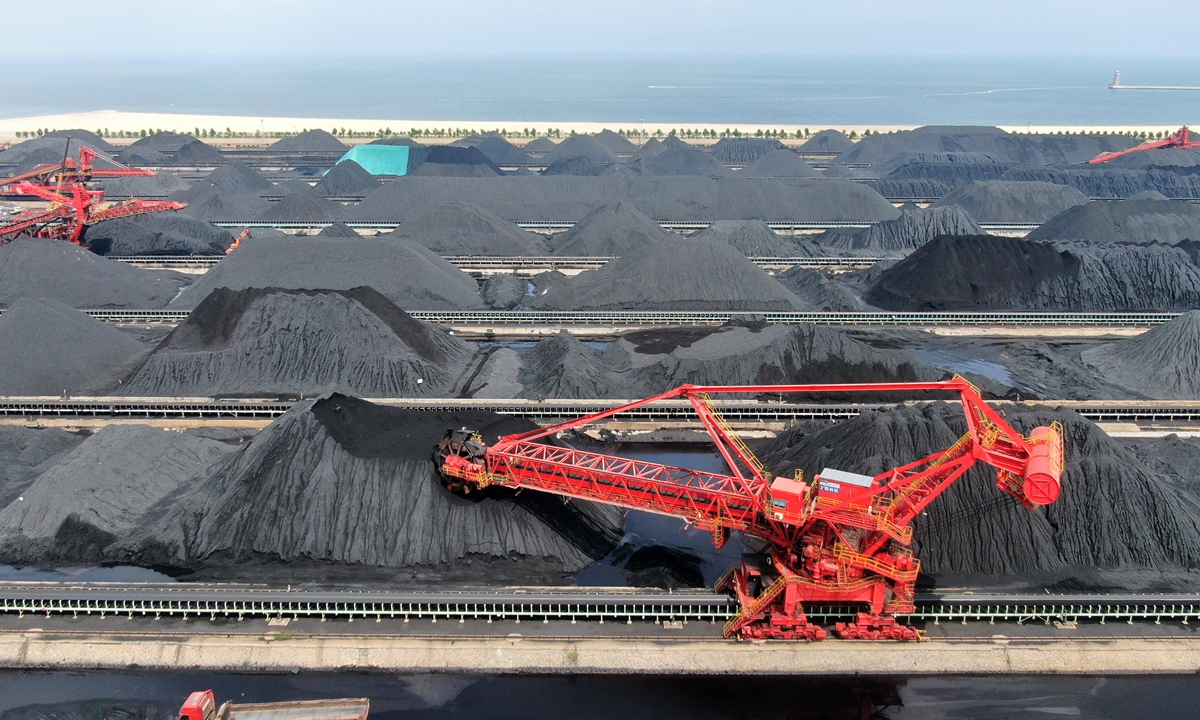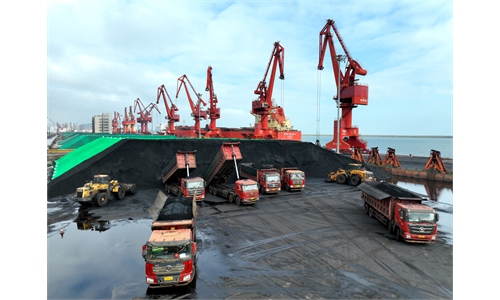China is in full swing to guarantee winter heating, with national railways ramping up capacity to ensure coal supply

A view of the coal yard at the Rizhao Port, East China's Shandong Province on August 18, 2022. Red reclaimers are rumbling, with trains full of goods ready to be exported. In July, China exported 230,000 tons of coal and lignite, a year-on-year increase of 171.6 percent, customs data showed. Photo: VCG
To cope with a cold wave, heating enterprises in Hohhot, North China's Inner Mongolia Autonomous Region, have already turned on the heat, the city government said on Monday.
Hohhot predicted the city will use 2.1 million tons of coal during the current heating season, with sufficient coal purchase agreements having been signed to ensure supplies.
Hohhot is not alone. Hegang city in Northeast China's Heilongjiang Province said that eight local coal mines were approved for emergency coal supply, and the mines' production capacity is expected to rise by 1.14 million tons annually.
China Railway is also striving to ensure fast transport of coal. Normally, China has two key routes to transport coal, one from the country's west to east and the other from north to south.
Responding to rising market demand for Xinjiang-based coal, Shen Hongnan, a senior engineer of China Railway, said that 12 pairs of trains have been added on the lines from Linhe to Hami, and Urumqi to Lanzhou, which can increase freight capacity by 47,000 tons per day, according to the official WeChat account of China Railway on Tuesday.
The Taiyuan branch of China Railway is also increasing transport of coal, including optimizing operation of freight trains and increasing the frequency of trains.
Daqin Railway, a major coal artery in north China, operates 87 pairs of heavy-haul trains daily, and the line connecting Shijiazhuang and Taiyuan will have 14 additional trains, increasing the annual freight transport by 10 million tons.
On September 28, the Daqin Railway began a 25-day centralized maintenance, laying a solid foundation for the upcoming winter coal transportation.
The 653-kilometer Daqin Railway connects Shanxi, Shaanxi and western Inner Mongolia Autonomous Region with the country's booming east. Coal from the port of Qinhuangdao is sent to southern customs located at the Yangtze River and Pearl River deltas.
Since the national railway launched a special campaign to ensure coal supply in June, the transportation volume of Daqin line has exceeded 120 million tons, a year-on-year increase of 10.2 percent.
"China's coal supply for winter heating is ensured, given government departments' ramped-up efforts to increase coal production and market supply," Lin Boqiang, director of the China Center for Energy Economics Research at Xiamen University, told the Global Times on Wednesday.
China has sought to accelerte coal production capacity by 300 million tons in 2022 by approving higher production capacity, expanding output and putting new projects into operation.
During the coming winter, China is unlikely to see the power outage that hits some localities in 2021, including Central China's Hunan, East China's Jiangxi and Northeast China's Heilongjiang provinces, according to Lin.
"After a tough year in energy production, China has gone all out to ensure coal output and keep prices at a reasonable level," he said.
The government has made detailed plans to safeguard coal production including the signing of medium- and long-term contracts with coal producers, so overall supply is expected to be stable this winter, Wang Yongzhong, head of the Institute of World Economics and Politics under the Chinese Academy of Social Sciences, told the Global Times on Wednesday.
The country's top economic planner has sought to liberalize the on-grid price of electricity generated from coal, curbing irrational power consumption while encouraging firms to improve energy use efficiency. It also reformed the price-formation mechanism for coal to keep prices within a reasonable range.
Some cities have diversified their power supplies. Unit 6 of the Hongyanhe nuclear power plant in Northeast China's Liaoning Province is reportedly operating at 100 percent, which is set to provide heating to local residents over a land area of 242,400 square meters nearby, China Media Group reported in September.
Since the beginning of this year, domestic raw coal output has remained stable. China produced 2.93 billion tons of coal from January to August, an increase of 11 percent year-on-year, and imported 167.98 million tons of coal, a year-on-year decrease of 14.9 percent, according to data from the National Bureau of Statistics.



